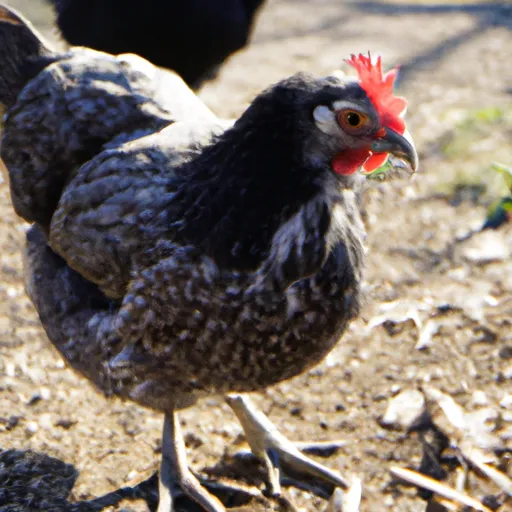Wyandotte Chicken 101: Everything You Need to Know about This Heritage Breed
Are you looking for a heritage breed that is both beautiful and functional?
Look no further than the Wyandotte chicken.
These birds are known for their striking appearance, but they also offer many practical benefits as well.
So let’s again go over everything you need to know about Wyandotte chickens, including their history, different breeds and colors, egg-laying abilities, care requirements, and more.
The Wyandotte Chicken
The Wyandotte chicken originated in the United States in the mid-19th century.
It was first bred by Mrs. John A. Baker of Rochester, New York, who named it after the Wyandot Indians who once lived near her home.
The breed quickly gained popularity due to its hardiness, docility, and excellent meat production qualities.
Today, there are several recognized varieties of Wyandottes, each with distinct physical characteristics and color patterns.
What is a Wyandotte Chicken
A Wyandotte chicken is a medium to large-sized bird with a stocky build and broad breast.
They have a roundish body shape, short legs, and a wide stance.
Their wings are relatively small compared to other breeds, which makes them less flighty and easier to handle.
One of the most notable features of the Wyandotte is its fluffy plumage, which comes in a variety of colors such as:
- black
- white
- buff
- golden laced
- silver laced
- blue
Different Breeds and Colors of Wyandottes
There are eight recognized varieties of Wyandottes, each with unique physical characteristics and color patterns.
Some of the most common include the following:
American: This is the original Wyandotte breed and has a brown-red coloration with black tail feathers.
Australian: This variety has a lighter coloration overall, with a cream or light tan base color and black markings on the neck, back, and wing tips.
Buff: As the name suggests, these birds have buff-colored plumage with darker shading on the hackles, tail feathers, and beaks.
See also Why Wyandottes are the Ultimate Cold Weather Chicken
Golden Laced: This popular variety has a yellow-gold base color with black lacing throughout the feathers.
Silver Laced: Similar to the golden laced, but with silvery gray instead of gold.
White: As the name implies, these birds have pure white plumage with black eyes and skin.
Are Wyandottes Good Egg Layers
One of the main advantages of keeping Wyandotte chickens is their excellent egg-laying ability.
On average, these birds will produce around 200 eggs per year, making them a great choice for those looking to raise their own eggs.
Additionally, Wyandotte eggs are often larger than other breeds, with a rich orange yolk that is perfect for cooking and baking.
What Color Eggs Do Wyandotte Chickens Lay
The color of a Wyandotte’s eggs can vary depending on the specific variety.
Generally speaking, however, Wyandotte eggs tend to be either brown or green.
The exact shade may depend on factors like diet and genetics.
Golden Laced Wyandotte: A Popular Variety
If you’re new to raising chickens, one good place to start might be with the Golden Laced Wyandotte.
This variety is particularly popular among hobbyists due to its friendly temperament, attractive appearance, and reliable egg-laying capabilities.

Plus, their bright gold plumage adds a pop of color to any backyard coop!
Do Wyandottes Lay Year Round
While some chicken breeds may slow down or stop laying during certain times of the year (such as winter), Wyandottes are generally considered to be fairly consistent layers throughout the year.
Of course, factors like climate, feed quality, and stress levels can all impact a hen’s productivity, so it’s important to provide your flock with optimal conditions to ensure maximum output.
Are Wyandottes Noisy
Compared to some other breeds, Wyandottes are generally considered to be somewhat vocal.
However, they aren’t known for being overly loud or obnoxious. In fact, many people find their calls to be quite pleasant and melodic.
See also Are Ameraucana Chickens good Egg Layers?
If noise is a concern, consider choosing a quieter breed or investing in sound-absorbing materials for your coop.
The Lifespan of a Wyandotte
On average, Wyandotte chickens can live for up to six years or more when properly cared for.
However, their lifespan can vary based on factors like genetic predisposition, environmental conditions, and disease exposure.
To maximize your flock’s longevity, make sure to provide them with high-quality food, clean water, adequate shelter, and regular health checks.
How to Care for Your Wyandotte Chicken
Caring for Wyandotte chickens involves providing them with a safe and comfortable living space, nutritious food, fresh water, and routine maintenance.
Here are some basic guidelines to follow:
Provide ample space: Each adult Wyandotte should have at least four square feet of floor space inside the coop, plus additional room outside for exercise and foraging.
Keep them warm: Wyandottes do best in moderate climates, but if you live in an area with extreme temperature swings, consider adding insulation or heating elements to your coop.
Feed them well: Wyandottes require a balanced diet consisting mainly of layer pellets, supplemented with treats like vegetables and fruit. Make sure to keep their feeders and waterers clean and filled at all times.
Monitor their health: Regularly check your chickens for signs of illness or injury, and seek veterinary attention if necessary.
Collect eggs regularly: To encourage continued egg laying, collect eggs from your nest boxes daily and dispose of any cracked or dirty ones.
Overall, caring for Wyandotte chickens isn’t difficult, but it does require dedication and commitment.
With proper care, these birds can provide you with delicious eggs, companionship, and even help with pest control in your garden.
